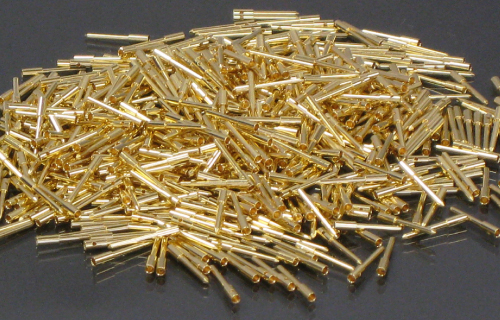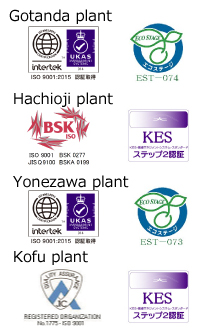Platings > by Metal > Gold Plating (Au)
Gold Plating (Au)

Gold is both soft and easily processed. Moreover, it exhibits exceptional chemical stability and corrosion resistance, ensuring its aesthetic appeal remains intact for extended periods. Consequently, it has served as a material for ornaments and coins since ancient times. Another notable characteristic is its high electrical and thermal conductivity.
Despite being such a remarkable metal, gold is renowned for its low yield and high cost. However, through a technique called plating, it's possible to impart these outstanding properties to materials in small quantities.
By gold plating, materials can acquire the following characteristics: corrosion resistance, low contact resistance, strong bonding properties, high conductivity, sealing abilities, high-frequency characteristics, high reflectivity, and thermal conductivity.
These characteristics obtained through gold plating find applications in connectors, sensor electrodes, semiconductor parts, optical components, medical devices, and more.
Although gold is expensive, Mitsuya enables cost reduction by controlling plating film thickness and selectively performing gold plating. Additionally, Mitsuya offers a wide range of gold plating options with unique characteristics such as hard gold plating, high-purity gold plating, and gold plating with increased reflectance.
Mitsuya provides 25 types of gold plating to easily showcase these characteristics. Clients can select the most suitable gold plating based on their product specifications, and Mitsuya can also propose optimal solutions.
Available platings
Pick up properties
We will introduce the property data about the gold plating (au) as follows.
These help you to find the property which you need.
Cobalt-Free / Nickel-Free
As previously stated, traditional hard gold plating often includes cobalt or nickel, both of which can be triggers for metal allergies. We offer hard gold plating options that are free from cobalt or nickel content. Additionally, we provide direct gold plating on SUS, eliminating the need for a nickel underlayer.
Contact Resistance
We offer gold platings with low contact resistance value.
Hardness
Hard gold plating is utilized in applications such as connectors, contacts, and probe pins that demand wear resistance. The addition of cobalt and nickel enhances the hardness of the gold. We offer a range of gold plating options, from soft gold plating to hard gold plating, to suit various requirements.
High-Temperature Solder
We offer gold-tin alloy plating, which ensures high reliability at elevated temperatures and serves as a lead-free option for step soldering. Mitsuya's gold-tin alloy plating boasts advantages such as consistent composition, even thickness, and the ability to exhibit alloy plating's melting characteristics. Our gold-tin alloy plating stands out for its uniform composition and thickness, showcasing the distinctive melting characteristics of this alloy plating.
Partial Gold Plating
We can propose ideas for achieving high performance and cost reduction.
Purity
The purity of gold in plating solutions can range from 70 wt% to 99.9 wt%, depending on the type of solution used. You have the flexibility to choose between pure gold and alloys, considering factors such as hardness, optical reflection, bonding strength, and solder melting properties.
Reflectance
We can introduce a high reflective gold plating, which has a higher reflectance compared with the traditional bright gold plating. Highly reflective gold plating is used for reflectors and condensers.
Solderability
We offer and recommend the appropriate type and thickness of gold plating for optimal solderability.
Sealing Treatment
Thinning of the gold plating can lead to the formation of pinholes, potentially causing corrosion in both the base plating and underlying materials. Enhancing corrosion resistance involves sealing these holes, a process that can be customized according to your preferences, whether you opt for water-soluble, non-aqueous methods, or others.















